Abit AT8: µGuru comes to the RD480
by Gary Key on March 10, 2006 12:05 AM EST- Posted in
- Motherboards
Abit AT8: Features
The ULi SATA ports are conveniently located above the number two IDE port connector and to the right of the CP80P post port debug LED. The SATA ports feature the new clamp and latch design, but are not color-coded. The chassis panel is located on the bottom left edge of the board below the CP80P LED. We do miss the power on and reset buttons from previous Abit boards.
The µGuru chipset is located above the ULi SATA ports and independently controls the µGuru functions . The TI TSB43AB22 IEEE 1394 chipset is located above the µGuru chipset. The IEEE 1394 connector is color-coded red and is located directly to the left of the TI IEEE 1394 chipset. The yellow clear CMOS jumper block is a traditional jumper design located to the left of the IEEE 1394 connector and along the edge of the motherboard. The red GURU connector is located below the CMOS jumper and also along the edge of the motherboard.
The first PCI Express x1 connector is located below the 4-pin power connector that must be used if two video cards are installed. The first physical PCI Express x16 connector is located next, followed by the second PCI Express x1 connector, second PCI Express x16 connector, and the two PCI 2.3 slots. The floppy drive connector is located below the second PCI slot and is inconveniently located for most case designs. The third of six fan headers located on the board is located to the right of the floppy drive connector.
We did not have any issues installing our ATI X1900XT video cards in the first and second x16 PCI Express slots. These dual slot configuration cards will physically render the second PCI Express x1 and first 32-bit PCI slot useless. We did not have any issues utilizing these slots with video cards containing single slot cooling systems. The first PCI Express x16 connector is considered to be the secondary slot and the second PCI Express x16 connector is considered to be the primary slot. If you utilize one video card, it must be installed in the primary slot. Abit ships a shadow card to use in the secondary slot in single video card configurations, but we found that it was not necessary to use the card. When we installed our EVGA 7800GTX 512MB card in the primary slot, it blocked the first three SATA ports.
The ATI Crossfire Xpress 200 chipset is passively cooled with a small heat sink unit that did not interfere with any installed peripherals. This unit along with the heatpipe running to the large PVM heat sink kept the chipsets cooled well during overclock testing.
Abit places the ATX12V auxiliary power connector at the top of the CPU socket area. This connector is located in an unusual position and could hamper airflow with cabling that crosses directly over the CPU heat sink/fan; although, we did not have any issues in our case.

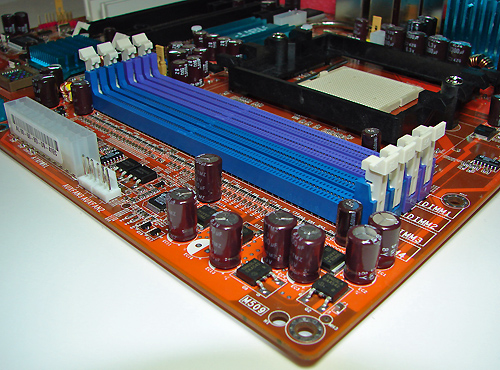
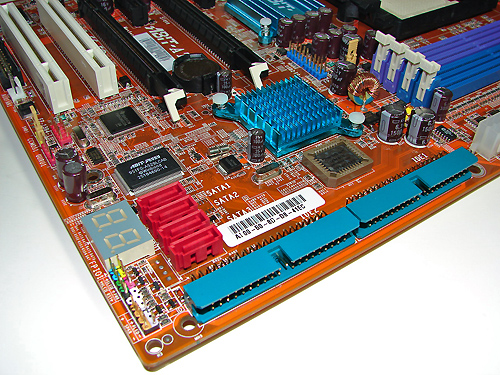
The ULi SATA ports are conveniently located above the number two IDE port connector and to the right of the CP80P post port debug LED. The SATA ports feature the new clamp and latch design, but are not color-coded. The chassis panel is located on the bottom left edge of the board below the CP80P LED. We do miss the power on and reset buttons from previous Abit boards.
The µGuru chipset is located above the ULi SATA ports and independently controls the µGuru functions . The TI TSB43AB22 IEEE 1394 chipset is located above the µGuru chipset. The IEEE 1394 connector is color-coded red and is located directly to the left of the TI IEEE 1394 chipset. The yellow clear CMOS jumper block is a traditional jumper design located to the left of the IEEE 1394 connector and along the edge of the motherboard. The red GURU connector is located below the CMOS jumper and also along the edge of the motherboard.
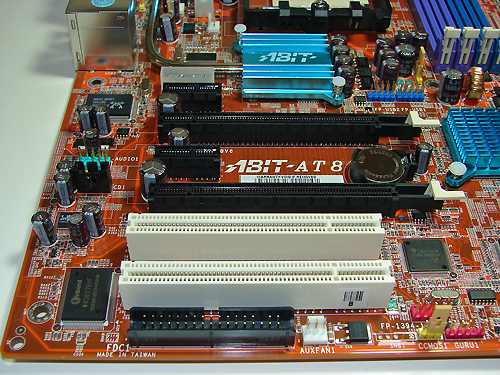
The first PCI Express x1 connector is located below the 4-pin power connector that must be used if two video cards are installed. The first physical PCI Express x16 connector is located next, followed by the second PCI Express x1 connector, second PCI Express x16 connector, and the two PCI 2.3 slots. The floppy drive connector is located below the second PCI slot and is inconveniently located for most case designs. The third of six fan headers located on the board is located to the right of the floppy drive connector.
We did not have any issues installing our ATI X1900XT video cards in the first and second x16 PCI Express slots. These dual slot configuration cards will physically render the second PCI Express x1 and first 32-bit PCI slot useless. We did not have any issues utilizing these slots with video cards containing single slot cooling systems. The first PCI Express x16 connector is considered to be the secondary slot and the second PCI Express x16 connector is considered to be the primary slot. If you utilize one video card, it must be installed in the primary slot. Abit ships a shadow card to use in the secondary slot in single video card configurations, but we found that it was not necessary to use the card. When we installed our EVGA 7800GTX 512MB card in the primary slot, it blocked the first three SATA ports.

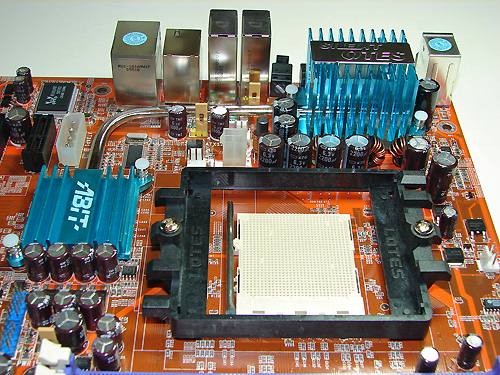
The ATI Crossfire Xpress 200 chipset is passively cooled with a small heat sink unit that did not interfere with any installed peripherals. This unit along with the heatpipe running to the large PVM heat sink kept the chipsets cooled well during overclock testing.
Abit places the ATX12V auxiliary power connector at the top of the CPU socket area. This connector is located in an unusual position and could hamper airflow with cabling that crosses directly over the CPU heat sink/fan; although, we did not have any issues in our case.
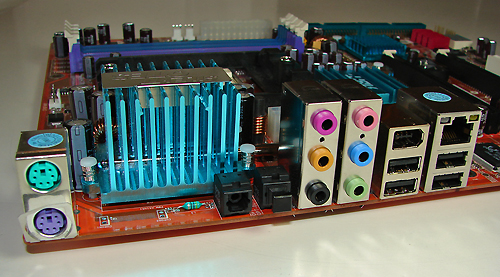










42 Comments
View All Comments
prohandyman - Friday, March 10, 2006 - link
Oh, the CONROE WILL DESTROY comments! I admit, Intel has stepped up to the plate with an amazing leap... but it IS 6 months out... and all "benchies" are being done on TODAY'S AMD platform. We know AMD has had some teething problems with AM2, and is on a "delayed" launch... but somehow I can't help but wonder if AMD was Waiting for this "announcement" just to see where they need to "tweak" the AM2/F platform to compete equally?! I know... Tom's and Anand's have done testing on "prototype" platforms... but even they will admit that the cpu silicon is NOT what will be released... However, the mobo platforms are, and are very mature. The unknown is the CPU, I don't even think "AMDs partners" are even in the total know.Beenthere - Friday, March 10, 2006 - link
Gary, it's nice to see an honest mobo review that doesn't sugar coat the mobo problems and hype the shit outta the product.It's pretty clear the Abit AT8 isn't ready for prime time yet, nor is the A8R-MVP, A8R-32, RDX200, or the Sapphire Pure whatever we're calling it this week. It's a real pity the reviews of all the RD480/RD580 mobos wasn't as honest as your review of the AT8 or Xbit Labs of the A8R-MVP. If they were then the mobo companies would have been forced to fix these deficient mobos or scrap them as none of them perform properly.
I realize that many fanboys will buy anything just to have the latest and worst product dumped into the marketplace this week. Unscrupulous companies depend on these sheep for quick revenue from malfunctioning products. Hopefully Abit will take the high road and fix their AT8 memory, BIOS, etc. issues Unlike Asus, Sapphire, et al who continue to pedle non-working mobos.
Until such time as the problems are fixed on all of the ATI chipset mobos, they simply are not ready for sale to the public. It's simply amazing how inept the mobo makers were in rushing the ATI chipset mobos out the door when they can't even operate with standard industry memory. With the AM2 socket mobos only a couple months away it looks like the ATI chipset mobos are not worth the trouble for a half-baked POS.
Maybe on the next go around ATI will get their act together and deliver a quality northbridge and southbridge (SB600)? ATI should also show the mobo companies how to copy the ATI reference mobo design which worked just fine and didn't have any of the foolish problems on the rushed out the door POS RD480 & now the RD580 mobos.
Gary Key - Friday, March 10, 2006 - link
I think you would find several Asus P5N32-SLI users that would disagree with you in regards to my review and conclusions about that product. ;-)
While I will agree there have been teething issues with the ATI RD480/580 products, overall I believe their launch was not any worse than the NVIDIA nFx series. In fact, there are numerous people who would say the nF4 is not ready for sale based upon issues they continue to experience. Some of the board manufacturers are clearly better than others at times but they all have issues as well as success in product launches. It is the determination of what a true issue is that makes the difference and how well a supplier responds to these issues.
Obviously, this board (AT8) has a bios issue with various types of memory from certain manufacturers. Who do we blame? Our first thought and reaction is to blame Abit. In this case, they deserve some of it as the memory incompatibilities are with a few well known and widely purchased modules. However, what happens when we find out in regression testing that one of the memory module suppliers has tweaked their SPD settings to the point that it is near impossible for Abit or ATI or anyone else to ensure their board or chipset will work properly with the component? How many people are having memory related issues with the other boards because of this tweaking but do not realize it is the memory and not the board at fault? Who gets the blame because the memory worked fine in one board and not another, we typically blame the board manufacturer, right or wrong. We find the board manufacturer's tweaking the memory performance to gain an advantage and the memory supplier is doing the same, it is a recipe for disaster at times. There have been numerous complaints about the memory voltages available on the newer boards as they do not allow the older BH5 type memory to be fully exploited in overclocking situations. Everyone is upset with the board supplier when they are trying to protect us from ourselves when running 3.3V or higher with the newer Infineon or Samsung modules will blow the DRAM in short enough time. At times the supplier cannot win but this does not excuse them from trying to assist, solve, or acknowledge issues.
We complain about the voltage fluctuations and inability for a system to remain stable yet we want to use the least expensive power supplies and other components while trying to run the system at 325HTT with CrossFire or SLI, voltages maxed on the CPU and DRAM, along with a couple of hard drives and optical drives attached to the system. Most people will call the board sub-standard or its components instead of wondering why we have video solutions pulling 275w and 30amps or better along with CPUs coming close to that number in overclocked conditions. We all want high quality components and as many features as possible on a board but as some point the suppliers have to make a cost decision as to what will get cut or reduced in order to sell the component at a competitive price and still make a profit.
I will be the first person to say I do not like seeing the voltage fluctuations on my A8R-MVP, but has it affected the ability of the system to perform 24/7 or caused a stability issue in numerous hours of continuous LAN play or testing, NO. Would it be an issue if I overclocked the system to the max (all components) and expected the same stability results, YES. I look at this board as a great bargain and one offering very good performance for $95. I expect it to have issues when pushed, but no more so than any other $95 board. I realize some corners were cut in the choice of components in order to make this price target but then I know what to expect when the board is being pushed to the edge. After testing the AT8, do I believe Asus could have done a better job in the voltage fluctuations, layout, and options, YES, but at what cost? The answer might be none or it might be the product ended up costing $25 more. I would be willing to pay it but is the target market willing to and do they even care. Our expectations are sometimes different than reality.
Was I upset that Asus did not release the features in the AR8 bios we utilized for testing until well after the board was in the market, YES again, but Wes ensured the test bios was available to anyone who needed it. We have addressed this issue on numerous occasions with them and other board manufacturers upon receiving a board now. We will call them out on it in a more direct way now. Personally I really learned a lesson the hard way with the Asus P5N32-SLI as some of the features in the bios and components on the board I tested are not available. That affects my integrity as a reviewer and I do not like the situation I was put in.
Do I think some suppliers rush a product to market; absolutely they do at various times. Do we like it, NO but there are just as many that will say YES as they want the latest and greatest no matter the cost. The suppliers will do it for a variety of reasons at times and we all have an opinion on the subject. There are several products we have received that we sent back in short order with advice to the suppliers not to release it and at times we will not review a product knowing there could be an issue with supply, pricing, or quality.
Have we made mistakes before, yes. However, I think you will find we are very honest about admitting it and will do whatever it takes to correct it. I also believe we are very consistent in our results and product recommendations. Probably 95% of the review sites had the same opinion about the Asus ATI boards, some better than others but overall most recommended a buy decision on the boards. I saw our initial test results, spoke at length with various people testing the boards, and knew the conversations with Asus about the positives and negatives. I bought two of the boards (A8R) for use at home and do not regret it. I am not saying this to excuse any issues that have been reported by the user community but just stating my expectations were probably different than others who bought the board for a different purpose. I really think not having the SB600 is an issue far deeper than what we first realized when the boards came out as the development time with the ULi M1575 minimal but those issues have been solved now.
As long as we have the freedom in the PC marketplace to mix and match an almost unlimited amount of components together there will be hardware/software issues with various configurations. We do our absolute best to ferret out these issues in our testing but we cannot test every possible combination of hardware and software available. We utilize our best judgment on the range of components that probably 85% of the general population will utilize and do our absolute best to test several different items in each category. As an example, utilizing several different power supplies, memory types, and video cards during testing to verify the capability of the system with these various combinations along with a wide variety of software (how many sites will test Office, Skype, and a webcam together) titles.
We have a stack of power supplies from just about every supplier setting on the floor now that are useless (we blew them) due to our new testing regimen in overclocking the systems to find their limits. Where do you draw the line? We would love to take however much time we could to fully explore every combination and nuance of a motherboard before publishing an article. This is not feasible so we do our absolute best to test the systems in the same manner in which they will be used by the target market separate of our standard test suites. A $220 DFI board built and marketed for those 5% of people who absolutely push a system to its limits will be looked at totally different way than a $65 board with on-board graphics whose primary purpose in life is to allow someone to connect to Internet and do their home/office work. We sometimes blur the lines between the two as our expectations are different than what the product really is intended to do. Is it that we got hyped or the supplier pushed the product too hard in the wrong market area, sometimes it happens but more often than not we call it right; however there are times when we need to fully communicate our position on the product so those expectations are not set incorrectly. What we perceive, experience, and test as being the best bang for the buck at $XX might very well fail to meet the expectations of a user who needs product that is designed for their actual purpose and is settling for less. In this case we will have a difference of opinion, a difference that hopefully we can work out in this open forum.
I am not being defensive but wanted share my opinion and thoughts. The readership of this website has the right to openly express their opinions about the articles we publish and we find the information invaluable. It is these comments, opinions, and discussions that allow us to improve our services and hopefully provide more meaningful feedback to you and the suppliers regarding issues. It also pushes us to improve the information and testing feedback we provide in the articles and hopefully overtime we address any testing shortcomings while providing a few surprises along the way.
Wesley Fink - Friday, March 10, 2006 - link
There are NO sugar-coated motherboard reviews here. It is also getting very old to see your A8R-MVP trash comments on every motherboard review we post. You may be surprised to learn that Gary owns two Asus A8R-MVP motherboards and he is very happy with them, but he can speak for humself.Gary and I both take our review responsibilities very seriously, and we have spent countless hours working with manufacturers and readers when problems crop up before, during, and after a review. Both Gary and I worked on an x2 issue with the A8R32-MVP the last few days that resulted in a fix and new BIOS in 2 days.
If you check the reviews, Tech Report, Hard OCP, Hot Hardware, and almost every site that reviewed it posted very positive reviews of the Asus A8R32-MVP when it launched on March 1.
We hear you. We do NOT agree.
samuraiBX - Friday, March 10, 2006 - link
I appreciate the level of professionalism Gary and you bring to your reviews. I was actually impressed by the speed at which you responded to questions raised in the forums in the Conroe testing as well as mentioning in this article that you will be testing using the new bios. The only ask for one thing; would it be possible to add a graphically intensive RTS to the tests? I don't tend to play as many FPS games, and while I understand they are the most graphically intensive, I would like to see the benchmarks for something like Rome:total war. Thanks again guys.Gary Key - Friday, March 10, 2006 - link
I am a RTS/MMORPG/Simulation gamer big time. We have looked at the various games available and thought we had a good demo for AOE III but the game has a bug in the AA/AF settings that greatly affect the outcome of scores at different resolutions. We are still working on providing a benchmark in this gaming area without resorting to FRAPs. Hopefully we will have one available soon that is repeatable and consistent.
CrystalBay - Friday, March 10, 2006 - link
Yeah, I have to agree with you guys. I hope Abit starts rolling big again.Sh0ckwave - Friday, March 10, 2006 - link
Agreed. It would be awesome for Abit to compete with DFI and ASUS in the enthusiast market again.tuteja1986 - Friday, March 10, 2006 - link
Abit is back in business and making awesome board again. I want to read the ABIT's SLI-32 motherboard review :)prohandyman - Friday, March 10, 2006 - link
I wonder why the review of "the older/ now economy" Abit ATI 200 chipset for crossfire board, especially since it is known to have some problems (the chipset and microcode)? The recently announced AT8-32X looks to be an even more exciting board, and from what I can see, is laid out better then the Asus equivalent. The newest addition to crossfire looks to be even more exciting then this first attempt! However, I see Asus/Ati are having microcode growing pains with the recently released A8R32-MVP Deluxe.Don't get me wrong, great review... very informative. Hopefully a follow-up using the Crossfire 3200, AT8 32X shows an even more mature, and higher performing board!